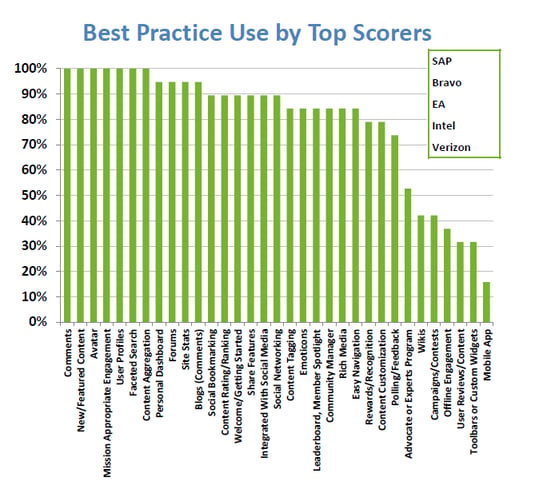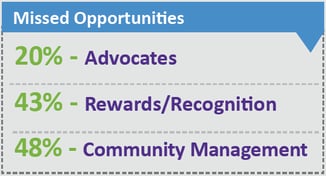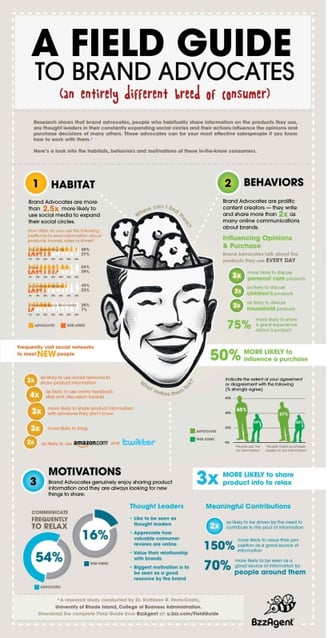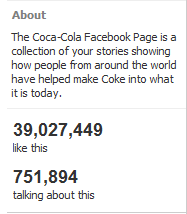It's almost certain that at some point, you've been told that your brand needs an advocacy program. You're not quite certain what the benefits are, what costs are involved, or how you should approach it, but you know that you need an advocacy program. While the costs can vary widely depending on your organization and the scale of your rewards, the benefits are nearly universal! Here we've shared four proven and actionable steps that will immediately improve the approach you're using (or considering) in your brand advocacy program! So, what is an advocate, and why do you need them?
Defining an advocate
A key point to remember is that just because you have a social media presence does not yet mean you have a community. According to Megan Berry, Senior Marketing Manager for Klout, you have a community when you are not only engaging your followers, but when they begin to independently interact with each other on a regular basis. As your community develops, you'll find that some of your followers are more active and helpful than the average community member. These are your advocates, a precious resource that you should nurture and guide!
A study conducted by ComBlu on the State of Online Communities in 2011 scores brands based upon their use of best practices in their communities. Over half of the brands which were considered "high scorers" incorporated the use of an advocacy program in their community! According to this same study, despite all of the obvious benefits to developing an advocacy program, at least 20% of brands are missing out!
Why do I want advocates?
The value received from your advocates is clear. So long as you take the proper time and efforts to regularly engage with your advocates and build a relationships between them and your brand, you can look forward to the following benefits:
- An advocate's increased activity can help bring a young community to life.
- As an outside source, advocates will generally be perceived to be more credible.
- Advocates can assist you in engaging with and responding to your growing fan base.
- Knowledgeable advocates can produce high-quality content about your brand.
- Advocates will actively promote your brand outside of your online community.
Once you have identified your advocates, you need to encourage (and reward!) these valuable resources in your fledgling community. From this investment, you will gain active and vocal advocates which will not only help you drive conversations and interest early on, but will also help in managing the sheer volume of interactions that must be addressed as your community grows! This begs the question of how you should go about the process of building a bond with your advocates.
How do brands bond with advocates?
- Recognize your advocates. One of the best ways to bond with your advocates is to give them a highly visible platform to voice their thoughts and opinions. Many of your advocates desire to be recognized as experts on the subjects that interest them. Through providing a visible platform with established traffic (such as posts in your corporate blogs) you provide the opportunity for your advocates to share their expertise, and be recognized by the community, their own friends and family, and other outside sources as a result.
Walmart is a shining example of this, with their Walmart Moms program. They provide real moms the opportunity to blog about a topic which interest them, and is relevant to Walmart's core demographics. Walmart showcases these blogging moms on their corporate website, with an attractive and easy to use slider interface, which identifies each blogger by name, a picture, their chosen topic, and an embedded link to their individual blogs. By doing so, they represent these moms as experts in their chosen subjects, and provide an opportunity for increased traffic (and better search rankings!) by linking to their blogs from the Walmart.com website.
- Don't be possessive. Your online community is very much an official source of communications for your company, but your advocates and followers are also heavily invested. While it is important to remove profane or offensive content from your online properties, it is also important to allow your advocates and fans to share their own ideas and opinions without fear of being censored. This further establishes credibility for your brand among your advocates, who will then spread the news of your credibility to the rest of the online (and even offline) world!
In late 2008, a Facebook fan page for Coca-Cola had attracted the attention of Facebook Inc. The page had been created by a couple of fans of the brand who were dissatisfied with the quality of other Coca-Cola fan pages. The page had become the second most popular page on Facebook, and per Facebook's own guidelines, needed to either be turned over to the brand, or shut down. Rather than demanding the owners turn over the page upon threat of prosecution, Coca-Cola instead contacted the creators of the Facebook page and created a solution with them. While Coca-Cola now maintains the page, they continue to respect the community, do not censor posts which comment on their competition, and they also provided a visit to the World of Coca-Cola, hockey tickets, and a tour of the Coke archives to show their appreciation to the page's original creators.
- Reward your Advocates. Advocates are often intrinsically motivated, they love your product, and they love talking about it with others. However, to really make the best use of your advocates, to encourage them to go the extra mile, and to ensure you've formed a lasting relationship with them that will not falter, you should reward your advocates for their efforts. Jeremiah Owyang suggests providing your advocates with special access and perks, but never directly paying them.
Using data from all across the web, Royal Caribbean found 50 of their most active and visible advocates and organized them into a group which they termed the "Royal Caribbean Champions." In May of 2007, Royal Caribbean cruises rewarded these fans with their first group event, the pre-inaugural sailing of what was at the time their newest ship, the Liberty of the Seas! This was the first time in history that such an event had been open to anyone who was not considered a "VIP." The event garnered loads of public attention and was a great way for Royal Caribbean to establish a devoted group of brand advocates!
Engage your advocates. Your advocates love knowing that their thoughts and opinions matter to your brand, and you should keep in mind that they are a great source for feedback! Thanks to a high level of activity within your online communities, and a natural love for your product, your advocates are likely to be well aware of what your community thinks of your products or services, and how they could be improved, and will have their own suggestions as well. Provide a platform for them to share these insights with you, it will make them feel more involved and useful, and it will provide your brand with top-notch feedback!
Pepsi's "Refresh Project" is the very embodiment of listening to and engaging with your advocates! Through this effort, Pepsi provides grants for projects which improve hundreds of schools and communities. All of the projects are derived from the ideas of the Pepsi online community, and these amazing projects help improve the lives of people all over the United States while also creating a positive image for the Pepsi brand!
Your brand advocates will be seen as an informal leadership in your community, and will gain the attention and respect of your followers. Don't neglect your brand's relationship with them. Be sure that you are establishing a bond with these influential members of your community, rather than leaving their continued participation up to chance!
Do you have your own tips for how to influence and reward your "superfans?" Or perhaps some feedback on our suggestions or additional case studies? Please let us know in the comments below, we would love to hear from you!
Tags:
Brand AdvocacyFeb 11, 2012









